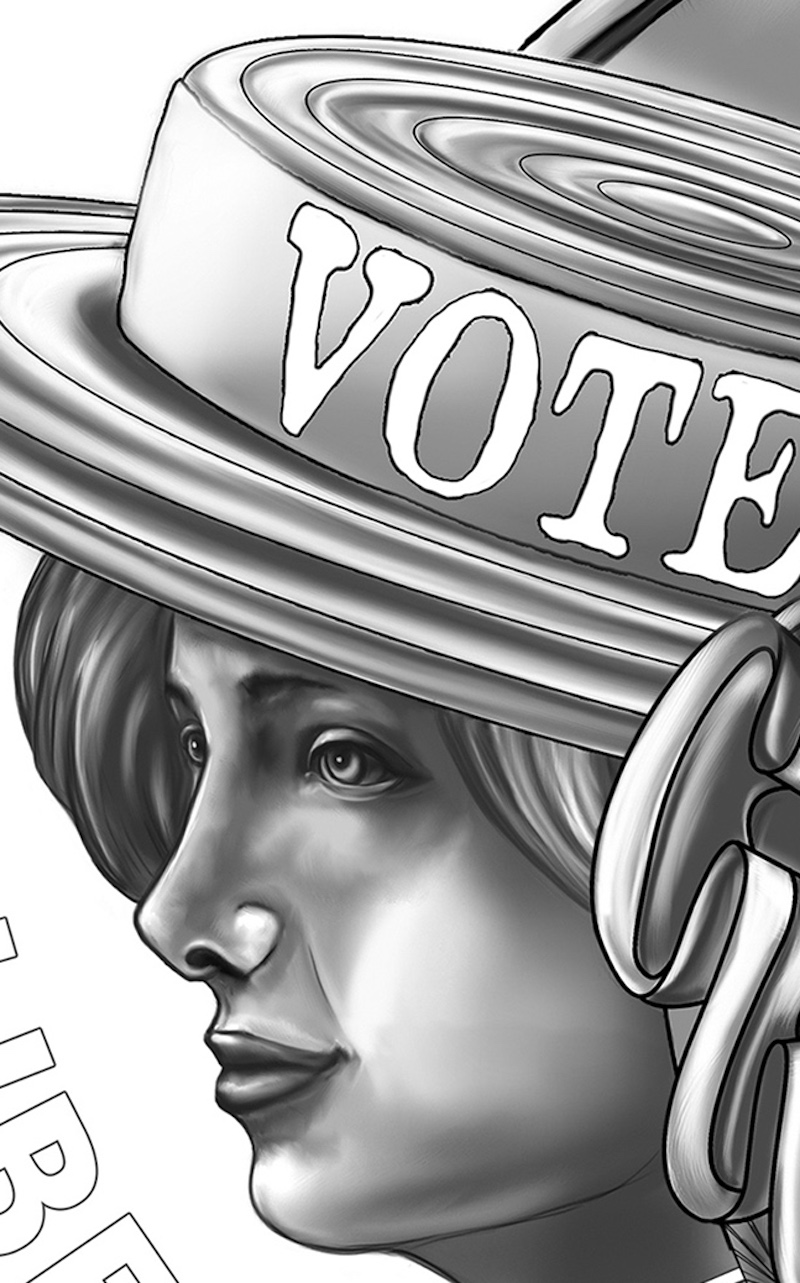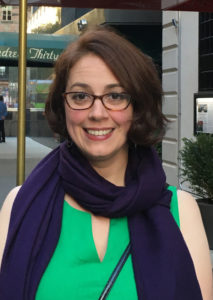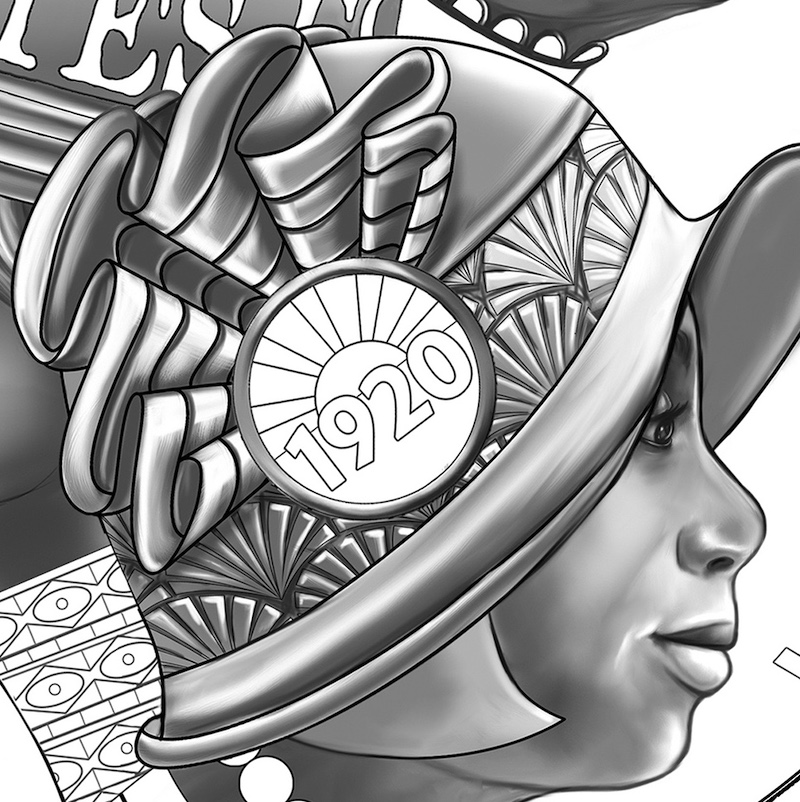
Illustration Chair Christina Hess designs U.S. Mint’s new $1 coin marking 19th Amendment
. . .
Tuesday, May 19th, 2020
It took nearly a century of protests and petitioning for American women to earn the right to vote.
Now, a century after the 19th Amendment was ratified on August 18, 1920, the U.S. Mint is releasing a $1 coin to commemorate the anniversary.
And PCA&D’s Christina Hess, Chair of the Illustration Department, was chosen to design the coin.
Hess is part of the Mint’s Artistic Infusion Program, a program established in 2003 to “enrich and invigorate” U.S. coin and medal designs. Members in the current group of 27 artists were selected last year based on artistic merit and demonstration designs.
It’s an honor Hess says she didn’t anticipate — but, she says, an honor that also recognizes the value of artists pushing their comfort zones when it comes to new challenges.
“When I saw the call for artists I didn’t think I would get picked,” Hess says. “I really did it for the experience of applying to something so unique. Even their application process was much different than anything I have done before. They are very heavy on the use of portraits. I don’t have a lot of portraits in my portfolio, so they saw something that they felt they could use.
“(It’s) important for artists to know: You really can never know what may resonate with people unless you give it a shot. This was a humongous win in my lengthy history of submissions, which includes a whole lot of misses.”
The coins will be minted later this year and available on the U.S. Mint’s website, and we talked to Hess about what it’s like to design something so iconic that will be seen by millions:
When were you selected to join, the U.S. Artistic Infusion Program, and what was the process?
CH: The mint sent out a call for artists in the summer of 2018. I applied by uploading my work and answering a few questions. From there the Mint selected a number of artists to complete a paid job. We had a choice between two themes. From there they selected artists to be part of their AIP. Twenty-seven artists were chosen out of 400-plus art submissions. Some were veterans from years before. I feel very honored to be part of such an amazing group.
What appealed to you about expanding your art in this way?
CH: Numismatic art is not only an art form, but it’s also a marker of history. I feel more as if I’m a visual recorder of events, interpreting the theme that I think may resonate with many people. It’s a challenge due to the small size of the final product. Many details cannot be coined but at the same time I’m amazed at what the sculptors and metal engineers are able to do! I’ve officially been an AIP artist for a little over a year and I’m still learning so much.

A detail from the reverse of the new U.S. $1 coin designed by Christina Hess. (Coin images courtesy U.S. Mint)
How did this particular pairing — you, with the suffrage coin — come about?
CH: There are actually two coins … one $1 (coin) and one medal. The $1 coin has a historical approach while the medal has a contemporary approach. The design managers approached me with creating images for the obverse and reverse of the historical theme. The contract was sent and I had the option of submitting to the contemporary theme as well. However, I wanted to spend all of my time on one theme. I created two designs for the obverse and two designs for the reverse. My designs were up for choice along with at least 20 other designs from other artists. The decision on which designs got picked went through a series of committees, at least three, including the Smithsonian.
Can you talk about the design process for this coin: What parameters were you given? What kind of research did you do for both the obverse and reverse designs?
CH: The process included a lot of research. I used numerous assets, including the materials the Mint and Smithsonian provided the artists. In addition to the numerous texts, links, photos, and background that they gave us we also had a discussion about what they may be looking for. All stakeholders and artists were in the call together to talk about the direction of the coin. The stakeholders did not specify anything particular due to wanting to see the artists’ interpretations.
Was there a hurdle that posed a particular challenge? How did you overcome it?
CH: After the call and researching the given materials I continued more online research, including (watching) movies about women’s suffrage. I wanted to encompass the breadth of time that the suffrage movement spanned. After numerous visuals (especially the movies) I was able to visualize more unique looks through the fashion of the decades that the suffrage movement spanned (and envision the different) ages and ethnicities of the women of the movement. The obverse was originally submitted with the left figure wearing glasses. I was asked to create a version without glasses. After the initial four rounds of edits, the committees congregated and chose my obverse design, which is where I continued with an additional seven edits — everything from small tangents that needed tweaked for coinability to raising the front figure’s hat so her eye was showing rather than hidden.
Was there anyone in particular who you used as a model for any of the three women on the coin?
CH: I found online historical photos that are public domain. There are so many out there! And they are beautiful. The women in back and front were pretty close to the reference while the mid figure is an amalgam of different references.
What stretched your practice the most with this AIP project?
CH: Conceptualizing a movement that lasted decades into one design. That’s tough to do. Who do you include? What do you leave out? How do you encompass a major undertaking by thousands of women in one small piece of artwork? And, most of all, how can you make it resonate with modern-day consumers?
What was the final step after your images were complete?
CH: The sculptors at the Philly mint completed 3D versions of the designs. I was fortunate enough to visit the Mint and see these beautiful renditions, created by sculptor Phebe Hemphill. She created plasticine versions and 3D ZBrush versions.
Was there a lot of back-and-forth between you and sculptor Phebe Hemphill?
CH: No! It’s pretty amazing. There was a lot of back-and-forth between the design manager, Vanessa Frank, and myself. She had a lot of back-and-forth with the chief engraver, Joe Menna. And I’m sure Joe had a lot of back-and-forth with Phebe. It’s collaborative, but with a lot of room for the artist to keep the original interpretation true to their initial design.
Do you have one of the coins?
CH: Not yet! The pandemic shut down production so they have not been minted yet. But I will!



